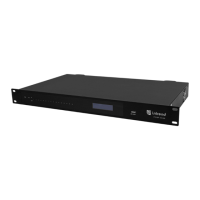Operating Manual for Digital Sound Processor (DSP) V3.0
WWW.INTREND-AV.RU
27
F
ig.3.6 Equalizer
Type: Parametric EQ is a default. High & low shelf filters and high & low pass filters can be selected.
Each kind of filter has different forms to achieve different functions.
High & Low Pass Filter: The reference frequency of pass-type filter is called cut-off frequency. Pass-
type filter allows the frequencies on one side of the cut-off frequency to fully pass the filter; in the
meantime, the frequencies on another side of the cut-off frequency are attenuated on a consecutive
basis. Among them, high pass filter allows the frequencies above the cut-off frequency to pass and
filter the frequencies below the cut-off frequency. To the contrary, low pass filter allows the
frequencies below the cut-off frequency to pass and also filter the frequencies above the cut-off
frequency.
High & Low Shelf Filter: It is also called shelf filter. High shelf filter means that the gain enhances or
attenuates for the frequencies above the set frequency. Low shelf filter means that the gain enhances
or attenuates for the frequencies below the set frequency. The set frequency is not 3dB cut-off
frequency but refers to the center of the failing edge or rising edge of the filter. Q value affects the
peak, and has a mathematical relation with the peak.
Frequency (Hz): It refers to the center frequency of the filter.
Gain (dB): It refers to the enhanced or attenuated decibel value of the gain at the center frequency.
Q: It refers to the quality factor of a filter. The adjustable range of Q value is 0.02-50;
When the filter is a parametric EQ filter, Q value refers to the width of the bell-shaped frequency
response curve on both sides of the cut-off frequency.
When the filter is a high & low shelf filter or a high & low pass filter, if Q>0.707, there will be peaks
in the filter responses. If Q<0.707, the slope will become flatter, and the roll-off will occur in advance.

